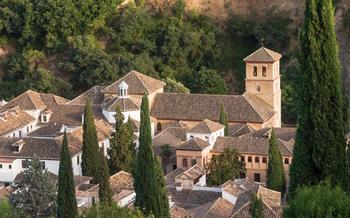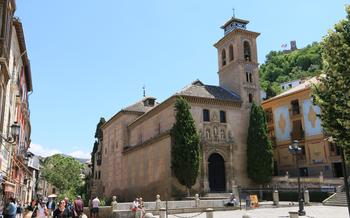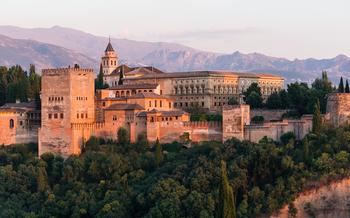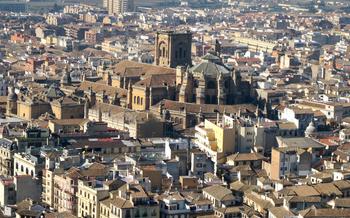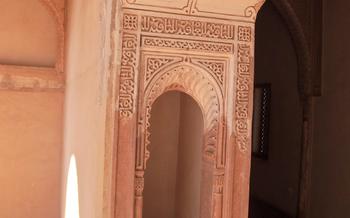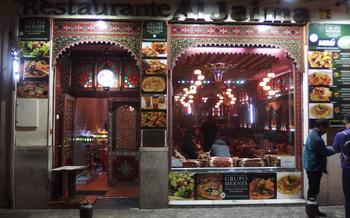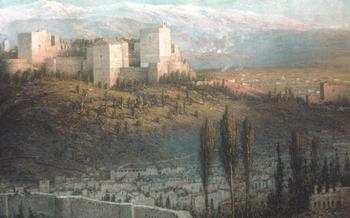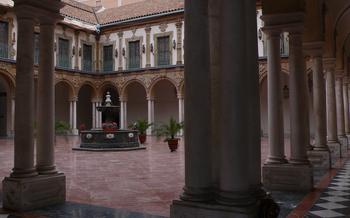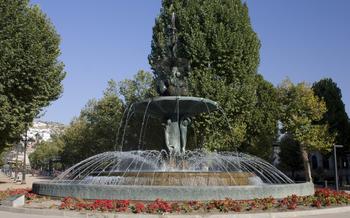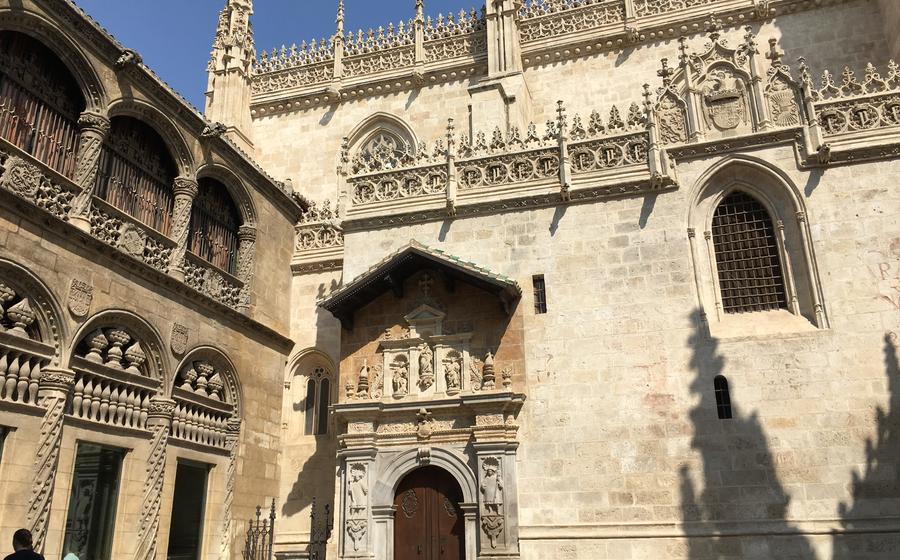
Royal Chapel of Granada
- A Majestic Final Resting Place
- A Symbol of Power and Faith
- An Artistic Masterpiece: A Fusion of Styles and Techniques
- The Royal Tombs: A Testament to Majesty
- The Altarpiece: A Masterpiece of Renaissance Art
- The Choir Stalls: A Symphony of Wood and Symbolism
- The Sacristy: A Treasure Trove of Sacred Artifacts
- The Royal Mausoleum: A Legacy Beneath the Chapel
- The Gardens: An Oasis of Serenity
- The View: A Panoramic Masterpiece
- The Neighborhood
- The History: A Legacy of Faith and Power
- The Legends: Unveiling the Enchanting Mystique
- Tips for Visitors: Making the Most of Your Visit
- Insider Tip: Experience the Magic of the Royal Chapel at Night
A Majestic Final Resting Place
The Royal Chapel of Granada stands as a testament to the legacy of Spain's influential rulers, the Catholic Monarchs, Ferdinand and Isabella. Constructed as their final resting place, the chapel exudes an aura of grandeur and reverence. Its architectural magnificence blends Gothic and Renaissance styles, showcasing intricate details that reflect the artistic mastery of the era. As visitors step inside, they are enveloped by a sense of awe and emotion, witnessing the tangible legacy of the monarchs who shaped Spain's history. The elaborate royal tombs, crafted from Carrara marble, symbolize their reign and accomplishments, evoking a profound connection to these historical figures. Here, in this sacred space, visitors can pay homage to the Catholic Monarchs and contemplate the enduring impact of their rule on Spain's cultural, political, and religious landscape.
A Symbol of Power and Faith
The Royal Chapel of Granada stands as a testament to the Catholic Monarchs' unwavering devotion to Christianity and their profound faith. This magnificent structure embodies their piety and serves as a symbol of the monarchy's political power and influence. Constructed during a pivotal period in Spanish history, the chapel reflects the fervor of the Reconquista, the triumphant Christian reconquest of the Iberian Peninsula from Islamic rule. The monarchs' unwavering commitment to this cause is evident in the chapel's grandeur and the intricate details that adorn its every corner. The Royal Chapel is not merely a burial site but a powerful symbol of the Catholic Monarchs' deep-rooted faith and their enduring legacy in shaping the course of Spanish history.
An Artistic Masterpiece: A Fusion of Styles and Techniques
The Royal Chapel of Granada stands as a testament to the artistic prowess of its time, showcasing a harmonious blend of Gothic and Renaissance styles. The chapel's construction was overseen by renowned architects, including Enrique Egas and Diego de Siloé, who masterfully integrated various artistic elements to create a cohesive and visually stunning masterpiece.
Intricate sculptures adorn the chapel's interior, depicting biblical scenes and figures with meticulous detail. The stunning stained glass windows, crafted by skilled artisans, bathe the chapel in vibrant hues, casting a mystical glow upon the sacred space. The intricate carvings on the walls and ceilings further enhance the chapel's visual appeal, showcasing the artistry and dedication of the craftsmen who labored on this magnificent project.
The harmonious fusion of Gothic and Renaissance elements in the Royal Chapel of Granada creates a unique and captivating aesthetic experience. The soaring Gothic arches, ribbed vaults, and pointed windows blend seamlessly with the Renaissance-inspired decorative elements, resulting in a masterpiece that transcends time and artistic boundaries.
The Royal Tombs: A Testament to Majesty
The Royal Chapel of Granada houses the elaborate tombs of Ferdinand and Isabella, the revered Catholic Monarchs who ruled Spain during a time of great transformation. Crafted from exquisite Carrara marble, these tombs serve as a testament to their reign and accomplishments.
The intricate details of the tombs symbolize the monarchs' power, piety, and legacy. Lifelike effigies of Ferdinand and Isabella lie in eternal repose, their hands clasped in prayer. The surrounding sculptures depict scenes from their lives, narrating their triumphs and contributions to the unification of Spain.
Visitors are captivated by the emotional connection to these historical figures, whose final resting place exudes an aura of reverence and respect. The tombs stand as poignant reminders of the enduring impact of the Catholic Monarchs on the course of Spanish history and culture.
The Altarpiece: A Masterpiece of Renaissance Art
The altarpiece of the Royal Chapel of Granada stands as a testament to the artistic prowess of the Renaissance period. Crafted by the renowned sculptor Felipe Vigarny, this stunning masterpiece is a symphony of intricate carvings and polychrome techniques that depicts scenes from the life of Jesus Christ. The central panel showcases the crucifixion, flanked by representations of the Annunciation, the Nativity, and the Resurrection. The lifelike figures, expressive faces, and attention to detail are a testament to Vigarny's exceptional skill and artistry. The altarpiece serves as a focal point of the chapel, drawing the eye with its beauty and religious significance, making it an essential element in the overall experience of visiting this sacred space.
The Choir Stalls: A Symphony of Wood and Symbolism
Adorning the interior of the Royal Chapel of Granada, the intricate choir stalls stand as a testament to the artistry and craftsmanship of the Renaissance era. Carved from rich walnut wood, these stalls are a symphony of intricate designs and symbolic motifs that captivate the eye and invite contemplation.
The skilled hands of master carvers transformed the wood into an array of biblical scenes, mythical creatures, and allegorical figures, each holding a profound meaning and representing a facet of religious faith. These carvings tell stories of virtue, redemption, and the triumph of good over evil, serving as a visual sermon for the monarchs and their court.
The choir stalls were not merely decorative, but also played a functional role in the religious ceremonies held within the chapel. Here, the Catholic Monarchs and their entourage would gather to attend mass, their voices blending with the melodious chants of the choir, echoing through the vaulted ceilings. The stalls provided a sense of order and hierarchy, each member occupying a designated space according to their rank and status.
Today, these magnificent choir stalls stand as silent witnesses to the grandeur and piety of the Spanish monarchy. They invite visitors to step back in time, to imagine the solemn processions, the whispered prayers, and the resonating hymns that once filled this sacred space, transporting them to a realm where art, history, and faith intertwine.
The Sacristy: A Treasure Trove of Sacred Artifacts
Adjoining the Royal Chapel, the sacristy serves as a repository for sacred objects and vestments used in religious ceremonies. Its intricate ceiling paintings, depicting scenes from the Bible and the lives of saints, create a visually stunning canopy. The sacristy also houses a collection of valuable artifacts, including reliquaries adorned with precious stones and liturgical items that have witnessed centuries of devotion. These objects, meticulously preserved and displayed, offer a glimpse into the rich religious heritage of the Catholic Monarchs and the profound significance of the Royal Chapel as a center of faith and spirituality.
The Royal Mausoleum: A Legacy Beneath the Chapel
Beneath the grandeur of the Royal Chapel lies the Royal Mausoleum, a solemn and serene resting place for members of the Spanish royal family. Descend into this subterranean chamber and immerse yourself in the history and legacy of Spain's monarchy.
Elaborate tombs and funerary monuments line the walls, each adorned with intricate carvings and inscriptions that tell the stories of the departed. Here, you'll find the remains of King Philip I, Juana la Loca, and other notable figures from Spanish history.
The mausoleum offers a glimpse into the lives and reigns of these influential individuals, providing a deeper understanding of the Spanish monarchy's rich history. Experience the weight of history as you stand among the final resting places of those who shaped Spain's destiny.
Whether you're a history buff, a lover of architecture, or simply seeking a place of contemplation, the Royal Mausoleum is a must-visit destination. Descend into the depths of the Royal Chapel and discover the hidden stories that lie beneath.
The Gardens: An Oasis of Serenity
Amidst the grandeur and history of the Royal Chapel, a serene oasis awaits visitors in the form of its tranquil gardens. Cypress trees, their tall, slender silhouettes reaching towards the sky, provide shade and a sense of tranquility. Fountains, their gentle melodies adding to the ambiance, create a soothing atmosphere that invites contemplation and relaxation. Well-manicured lawns, adorned with colorful flowers, offer a vibrant contrast to the chapel's stone facade.
These gardens, once a private retreat for the Catholic Monarchs, served as a place of solace and contemplation. The monarchs, burdened with the responsibilities of ruling a vast empire, found respite and renewal within these serene surroundings. The gardens, with their lush greenery and fragrant blooms, provided a sanctuary where they could escape the pressures of court life and reconnect with nature's beauty.
Today, visitors to the Royal Chapel can wander through these gardens, following in the footsteps of the Catholic Monarchs. The gardens offer a peaceful respite from the bustle of the city, inviting visitors to slow down, appreciate the beauty of nature, and find a moment of tranquility amidst the grandeur of the chapel.
The View: A Panoramic Masterpiece
Ascend the steps to the chapel's terrace and be rewarded with a breathtaking panorama that will leave you awestruck. The city of Granada unfolds before you like a living tapestry, its ancient landmarks and vibrant neighborhoods harmoniously blending together. The majestic Sierra Nevada mountains form a dramatic backdrop, their snow-capped peaks piercing the azure sky.
At sunset, the scene transforms into a kaleidoscope of colors, as the fading sunlight casts a golden glow over the city. The sky erupts in a symphony of hues, from fiery reds and oranges to deep purples and blues. The Alhambra, with its intricate silhouette, stands out against the vibrant canvas of the sky, its towers and ramparts casting long shadows across the landscape.
From this vantage point, you can trace the evolution of Granada, from its humble beginnings as a small Moorish settlement to its rise as a powerful kingdom and, eventually, a thriving modern city. The passage of time becomes tangible as you gaze upon the architectural wonders that dot the cityscape, each telling a unique story of Granada's rich history.
Whether you're a seasoned traveler or a first-time visitor, the view from the Royal Chapel of Granada is an experience that will stay with you long after your visit. It's a moment to pause, reflect, and appreciate the beauty and grandeur of this remarkable city.
The Neighborhood
Nestled in the heart of the Albaicín neighborhood, the Royal Chapel of Granada finds itself amidst a vibrant and historic urban tapestry. This neighborhood, a UNESCO World Heritage Site, transports visitors back in time with its intricate labyrinth of narrow streets and whitewashed houses, all exuding an irresistible charm.
The Albaicín is a treasure trove of cultural and historical significance, having served as a melting pot of civilizations throughout the ages. Its rich legacy is reflected in the diverse architectural styles that grace its streets, from the Moorish influences of the Nasrid dynasty to the Renaissance grandeur of the Catholic Monarchs.
Strolling through the Albaicín, visitors can immerse themselves in the neighborhood's vibrant atmosphere, where local traditions and customs intertwine with modern-day life. Artisans and craftsmen showcase their skills in small workshops, while lively squares buzz with the chatter of locals and the enticing aromas of traditional Andalusian cuisine.
The proximity of the Royal Chapel to other landmarks, such as the awe-inspiring Alhambra and the majestic Granada Cathedral, further enhances its appeal. This allows visitors to seamlessly weave the chapel's visit into a comprehensive exploration of Granada's rich cultural heritage.
Whether wandering through the picturesque streets, savoring local delicacies, or marveling at the architectural wonders that abound, the Albaicín neighborhood offers a captivating experience that complements and enriches the visit to the Royal Chapel of Granada.
The History: A Legacy of Faith and Power
The Royal Chapel of Granada, a testament to the grandeur and devotion of the Spanish monarchy, owes its existence to the vision of the Catholic Monarchs, Ferdinand and Isabella. In 1505, driven by their deep religious faith and political ambition, they commissioned the construction of this architectural masterpiece. The chapel was designed to serve as their final resting place, a symbol of their enduring legacy and the unification of Spain under their rule.
Completed in the 16th century, the chapel stands as a remarkable example of the transition from Gothic to Renaissance architecture. Its intricate blend of styles reflects the evolving artistic and cultural landscape of Spain during that era. The grandeur of the chapel's design, with its soaring vaults, delicate tracery, and ornate ornamentation, epitomizes the power and prestige of the Spanish monarchy.
As you step inside the chapel, you are transported back in time, surrounded by the echoes of history. The walls whisper tales of the Catholic Monarchs' unwavering faith, their political triumphs, and their profound impact on the course of Spanish history. The chapel serves as a tangible reminder of their reign, a testament to their enduring legacy as the architects of a unified and powerful Spain.
The Legends: Unveiling the Enchanting Mystique
Beyond its historical and artistic significance, the Royal Chapel of Granada is steeped in a rich tapestry of legends and stories that have captivated the imaginations of visitors for centuries. One of the most famous tales is the legend of the "Hand of Justice." This mythical hand, said to be made of silver, was believed to possess the power to detect lies and punish wrongdoers. It was reportedly used during the reign of the Catholic Monarchs to ensure justice and fairness in their kingdom.
Another intriguing legend associated with the chapel tells of a hidden treasure buried beneath its foundation. According to the story, the Catholic Monarchs hid a vast fortune in gold and jewels within the chapel's walls to protect it from falling into the wrong hands. Over the centuries, many treasure hunters have attempted to locate this hidden wealth, but none have succeeded.
These legends add a layer of mystery and intrigue to the Royal Chapel of Granada, capturing the imaginations of visitors and locals alike. They serve as a reminder of the rich cultural heritage and storytelling traditions that are deeply intertwined with Spain's history and identity.
Tips for Visitors: Making the Most of Your Visit
When visiting the Royal Chapel of Granada, it is important to dress respectfully, as it is a sacred space. Allow ample time to explore the chapel and appreciate its intricate details. Guided tours are available for those who want a deeper understanding of the history and significance of the chapel. To make the most of your visit, combine it with other nearby attractions, such as the Alhambra and the Granada Cathedral. These landmarks offer a comprehensive exploration of Granada's rich history and cultural heritage.
Insider Tip: Experience the Magic of the Royal Chapel at Night
For an unforgettable and enchanting experience, visit the Royal Chapel of Granada in the evening. As the sun sets and darkness envelops the city, the chapel transforms into a magical and ethereal space. The soft lighting casts a warm glow on the intricate details of the architecture, sculptures, and paintings, revealing hidden nuances and textures.
With fewer crowds during the evening hours, you can immerse yourself in the tranquility and serenity of the chapel. Take your time to wander through the naves, admire the stunning altarpiece, and contemplate the elaborate royal tombs. The absence of daytime distractions allows for a deeper connection with the history and symbolism of this sacred space.
Whether you're a history buff, an art enthusiast, or simply seeking a unique and spiritual experience, visiting the Royal Chapel of Granada at night is highly recommended. It's a chance to witness the chapel's beauty and grandeur in a new light, creating lasting memories of your time in this remarkable city.
